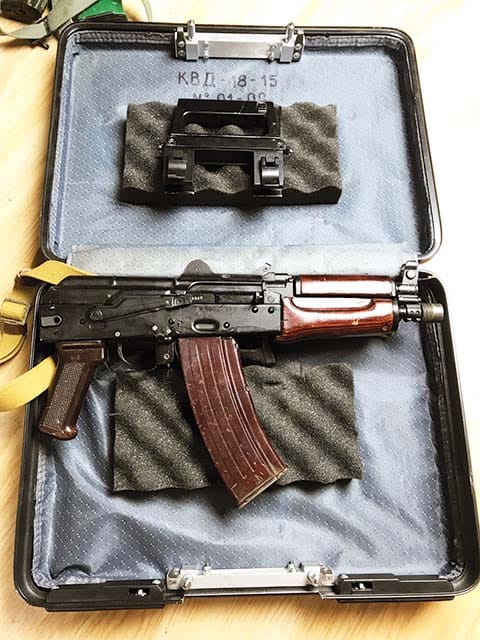By Lynndon Schooler

LYNNDON SCHOOLER
In the late 1970s, the Soviet Union had begun construction of sports facilities for the upcoming 1980 Moscow Summer Olympics. However, the Munich Summer Olympics massacre in 1972 paired with growing instability in the Middle East raised major security concerns for the Kremlin. The Soviet Union was to be on the world stage, and the KGB (the Committee for State Security) was tasked with personally guarding (and spying on) high ranking officials and foreign dignitaries. To address this need, the intelligence agency put out a request to its engineering department to produce a low-profile, discreet-carry, micro-caliber select-fire weapon, to be deployed rapidly when necessary and to be disguised as a common accessory so frequently seen that it disappears in plain sight.
History had proven that KGB agents needed to be armed with something more substantial than a pistol, as terrorist groups often used full-sized small arms abroad. However, the Soviets had strict size parameters to fit that something in an “Operational Briefcase.” The recently adopted AKS-74U was the natural answer, which, when folded, manages to just fit into what looks like an inconspicuous attaché case.
Several years prior, in 1973, the Ministry of Defense put out a solicitation for this compact assault rifle. Kalashnikov design’s bureau entry at the Izhevsk Arms Factory had won, and the rifle was officially adopted as the AKS-74U (folding AK-74 shortened) in 1979. The handy little rifle weighed in at less than 6 pounds with a rate of fire of 650 rounds per minute. The barrel extends slightly over 8 inches with an overall length of 19.29 inches, with the stock folded and 28.93 inches with the stock extended.
Recent Revival
Production started in Izhevsk and was moved in 1981-1982 to the Tula Arms Plant before production ended in 1993. The AKS-74U was first fielded in Afghanistan by Soviet Spetsnaz operators, who did not favor the compact weapon in the extended ranges and open mountainous area of operation, instead preferring the AKS-74. The AKS-74U saw greater success with pilots and vehicle crews. Pashtun Mujahideen gave the name “Krinkov” to
the compact assault rifle, and the West got their first look outside of Langley in the July 1984 issue of Soldier Of Fortune Magazine. Although the AKS-74U was not appreciated upon first issue to Special Forces, it has seen a recent revival, being pulled from security and police arsenals and given to modern special operations to use. The AKS-74U has decent ballistic performance and maintains a convenient length when suppressed. In personal interviews, several Russian soldiers with combat experience in Syria commented that they would have preferred using an AKS-74U instead of their AK-74Ms and AK-105s, despite a full suite of rails and upgrades.
Unlike the rugged and scaled-down AKS- 74U, its crafty case had to be of a more clever construction, offering concealed carry and a unique and rapid deployment method.

Another example of the KGB Escort Briefcase. MILES VINING
Concealed Carry Case
The case utilizes a cradle within the inner frame, which secures the weapon in place. The AKS-74U is connected to the case handle, which is detachable from the briefcase. The briefcase itself acts as a clamshell around the weapon. There is a safety and trigger on the handle to deploy the weapon from the case. When the safety is switched down and the trigger is depressed, the briefcase siding jettisons from the weapon, leaving the AKS-74U in the operator’s hand attached to the cradle. The operator can then employ the weapon effectively while unfolding the triangle stock to the deployed position and may engage the threat. The carrying handle does not obstruct the line of sight and can be removed if necessary when time allows by simply pulling back in the handle. A lever sets the tension to engage under the rear sight assembly.
The escort briefcase cannot shoot from inside the case. Instead, the weapon must be removed and deployed from the case to effectively employ the weapon to its full potential. The briefcase also allows two 30-round magazines to be taped together in the case and inserted into the weapon.
Two KGB Models
Currently there are two known KGB briefcase models. The earlier production version has the weapon sit horizontally with the booster removed. The AKS-74U can operate flawlessly with the booster removed. The second known case allows room for the booster and has a redesigned cradle and case to put the weapon at a 45-degree angle. The carrying handle’s attachment point is also redesigned. This late production model provides an improved view down the sites and may also be removed rapidly.
The general public first saw this type of operational briefcase in the famous Russian miniseries Brigada in 2002. The miniseries used the late production model with the AKS-74U at an angle in the briefcase. After a nearly 20-year service life, the briefcase had outlived the Soviet Union and swapped hands across multiple government law enforcement agencies, the KGB and the successor, the FSB.
At the end of its service life, the KGB escort briefcase has been replaced by means of carrying a compact personal defensive weapon and other classified means. Acquired by Western intelligence, the KGB briefcase lost its cover years ago. Other nations have dabbled with briefcase-deployed weapons, but both the early and later versions of the Soviet model comparatively provided greater control and real-world utility by advantageously allowing the shooter to use the weapon’s sights, apply target discrimination and reload. In conclusion, the KGB operational briefcase was ingenious for its time, giving rapid reactive firepower in a turbulent era. While obsolete, it is a keen reminder that things are not always what they seem, inviting one to wonder what the Russians have possibly thought up since.
| This article first appeared in Small Arms Review V23N8 (Oct 2019) |












